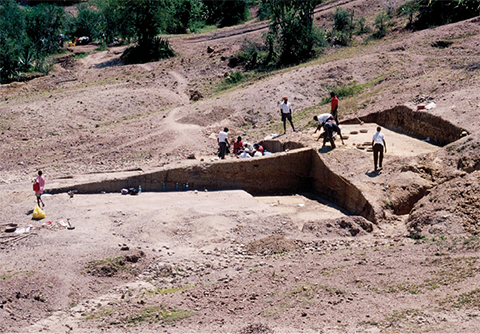Human hunting habits

Researcher finds earliest evidence of human ancestors hunting and scavenging
A Baylor University research study has shed new light on the diet and food acquisition strategies of some the earliest human ancestors in Africa.
Beginning around 2 million years ago, many scientists believe that early stone tool-making humans, known scientifically as Oldowan hominin, started to exhibit a number of physiological and ecological adaptations that required greater daily energy expenditures, including an increase in brain and body size, heavier investment in their offspring and significant home-range expansion. Demonstrating how these early humans acquired the extra energy they needed to sustain these shifts has been the subject of much debate among researchers.
A recent study led by Dr. Joseph Ferraro, assistant professor of anthropology in Baylor's College of Arts & Sciences, offers new insight in this debate with a wealth of archaeological evidence from the 2 million-year-old site of Kanjera South (KJS), Kenya. The study's findings were published in PLOS One.
"Considered in total, this study provides important early archaeological evidence for meat eating, hunting and scavenging behaviors -- cornerstone adaptations that likely facilitated brain expansion in human evolution, movement of hominins out of Africa and into Eurasia, as well as important shifts in our social behavior, anatomy and physiology," Ferraro said.
Located on the shores of Lake Victoria, KJS contains "three large, well-preserved, stratified" layers of animal remains. The research team worked at the site for more than a decade, recovering thousands of animal bones and rudimentary stone tools.
According to researchers, hominins at KJS met their new energy requirements through an increased reliance on meat eating. Specifically, the archaeological record at KJS shows that hominins acquired an abundance of nutritious animal remains through a combination of both hunting and scavenging behaviors. The KJS site is the earliest known archaeological evidence of these behaviors.
"Our study helps inform the 'hunting vs. scavenging' debate in Paleolithic archaeology. The record at KJS shows that it isn't a case of either/or for Oldowan hominins 2 million years ago. Rather, hominins at KJS were clearly doing both," Ferraro said.
The fossil evidence for hominin hunting is particularly compelling. The record shows that Oldowan hominins acquired and butchered numerous small antelope carcasses. These animals are well represented at the site by most or all of their bones, from the tops of their head to the tips of their hooves, indicating to researchers that they were transported to the site as whole carcasses. Many of the bones also show evidence of cut marks made when hominins used simple stone tools to remove animal flesh.
In addition, modern studies in the Serengeti -- an environment similar to KJS 2 million years ago -- have also shown that predators completely devour antelopes of this size within minutes of their deaths. As a result, hominins could only have acquired these valuable remains on the savanna through active hunting.
Other contributing authors to the study include Baylor's John W. Seaman III, BS '06, MS '07, Dr. Katie M. Binetti, Dr. John W. Seaman Jr. and several scholars from other institutions. Funding was provided by the National Science Foundation, Leakey Foundation, Wenner-Gren Foundation, National Geographic Society, The Leverhulme Trust, University of California, Baylor University and the City University of New York.
